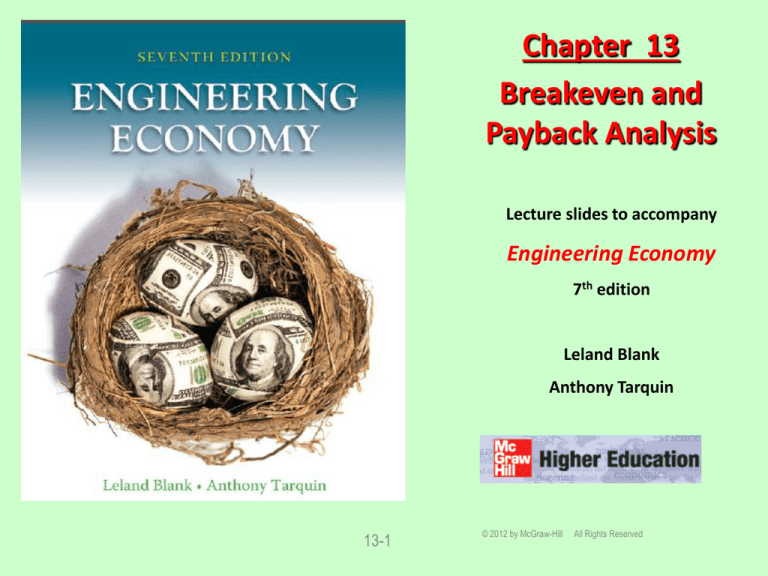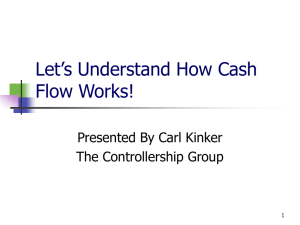
Chapter 13
Breakeven and
Payback Analysis
Lecture slides to accompany
Engineering Economy
7th edition
Leland Blank
Anthony Tarquin
13-1
© 2012 by McGraw-Hill
All Rights Reserved
LEARNING OUTCOMES
1. Breakeven point – one parameter
2. Breakeven point – two alternatives
3. Payback period analysis
13-2
© 2012 by McGraw-Hill
All Rights Reserved
Breakeven Point
Value of a parameter that makes two elements equal
The parameter (or variable) can be an amount of
revenue, cost, supply, demand, etc. for one project or
between two alternatives
One project - Breakeven point is identified as QBE. Determined
using linear or non-linear math relations for revenue and cost
Between two alternatives - Determine one of the parameters
P, A, F, i, or n with others constant
Solution is by one of three methods:
Direct solution of relations
Trial and error
Spreadsheet functions or tools (Goal Seek or
Solver)
13-3
© 2012 by McGraw-Hill
All Rights Reserved
Cost-Revenue Model ― One Project
Quantity, Q — An amount of the variable in
question, e.g., units/year, hours/month
Breakeven value is QBE
Fixed cost, FC — Costs not directly dependent on the variable, e.g.,
buildings, fixed overhead, insurance, minimum workforce cost
Variable cost, VC — Costs that change with parameters such as
production level and workforce size. These are labor, material
and marketing costs. Variable cost per unit is v
Total cost, TC — Sum of fixed and variable costs, TC = FC + VC
Revenue, R — Amount is
dependent on quantity sold
Revenue per unit is r
Profit, P — Amount of
revenue remaining after costs
P = R – TC = R – (FC+VC)
13-4
© 2012 by McGraw-Hill
All Rights Reserved
Breakeven for linear R and TC
Set R = TC and solve for Q = QBE
R = TC
rQ = FC + vQ
QBE =
FC
r–v
When variable cost, v, is
lowered, QBE decreases
(moves to left)
13-5
© 2012 by McGraw-Hill
All Rights Reserved
Example: One Project Breakeven Point
A plant produces 15,000 units/month. Find breakeven level if FC =
$75,000 /month, revenue is $8/unit and variable cost is $2.50/unit.
Determine expected monthly profit or loss.
Solution: Find QBE and compare to 15,000; calculate Profit
QBE = 75,000 / (8.00-2.50) = 13,636 units/month
Production level is above breakeven
Profit
Profit = R – (FC + VC)
= rQ – (FC + vQ) = (r-v)Q – FC
= (8.00 – 2.50)(15,000) – 75,000
= $ 7500/month
13-6
© 2012 by McGraw-Hill
All Rights Reserved
Breakeven Between Two Alternatives
To determine value of common variable between 2 alternatives, do the
following:
1. Define the common variable
2. Develop equivalence PW, AW or FW relations as function of common
variable for each alternative
3. Equate the relations; solve for variable. This is breakeven value
Selection of alternative is based on
anticipated value of common variable:
Value BELOW breakeven;
select higher variable cost
Value ABOVE breakeven;
select lower variable cost
13-7
© 2012 by McGraw-Hill
All Rights Reserved
Example: Two Alternative Breakeven Analysis
Perform a make/buy analysis where the
common variable is X, the number of units
produced each year. AW relations are:
AWmake = -18,000(A/P,15%,6)
+2,000(A/F,15%,6) – 0.4X
Breakeven
value of X
AW, 1000
$/year
AWbuy
8
7
AWbuy = -1.5X
6
Solution: Equate AW relations, solve for X
5
AWmake
4
-1.5X = -4528 - 0.4X
X = 4116 per year
3
2
1
If anticipated production > 4116,
select make alternative (lower variable cost)
0
1
2
3
4
5
X, 1000 units per year
13-8
© 2012 by McGraw-Hill
All Rights Reserved
Breakeven Analysis Using Goal Seek Tool
Spreadsheet tool Goal Seek finds breakeven value for the
common variable between two alternatives
Problem: Two machines (1 and 2) have following estimates.
a) Use spreadsheet and AW analysis to select one at MARR = 10%.
b) Use Goal Seek to find the breakeven first cost.
Machine
1
2
P, $
-80,000 -110,000
NCF, $/year 25,000 22,000
S, $
2,000
3,000
n, years
4
6
Solution: a) Select machine A with AWA = $193
13-9
© 2012 by McGraw-Hill
All Rights Reserved
Breakeven Analysis Using Goal Seek Tool
Solution: b) Goal Seek finds a first-cost breakeven of $96,669 to
make machine B economically equivalent to A
Changing cell
Spreadsheet after Goal Seek is applied
Target cell
13-10
© 2012 by McGraw-Hill
All Rights Reserved
Payback Period Analysis
Payback period: Estimated amount of time (np) for cash inflows to recover an
initial investment (P) plus a stated return of return (i%)
Types of payback analysis: No-return and discounted payback
1. No-return payback means rate of return is ZERO (i = 0%)
2. Discounted payback considers time value of money (i > 0%)
Caution: Payback period analysis is a good initial screening
tool, rather than the primary method to justify a project or
select an alternative (Discussed later)
13-11
© 2012 by McGraw-Hill
All Rights Reserved
Payback Period Computation
Formula to determine payback period (np)
varies with type of analysis.
NCF = Net Cash Flow per period t
Eqn. 1
Eqn. 2
Eqn. 3
Eqn. 4
13-12
© 2012 by McGraw-Hill
All Rights Reserved
Points to Remember About Payback Analysis
• No-return payback neglects time value of money, so no
return is expected for the investment made
• No cash flows after the payback period are considered in the
analysis. Return may be higher if these cash flows are
expected to be positive.
• Approach of payback analysis is different from PW, AW, ROR
and B/C analysis. A different alternative may be selected using
payback.
• Rely on payback as a supplemental tool; use PW or AW at the
MARR for a reliable decision
• Discounted payback (i > 0%) gives a good sense of the risk
involved
13-13
© 2012 by McGraw-Hill
All Rights Reserved
Example: Payback Analysis
First cost, $
NCF, $ per year
Maximum life, years
System 1
12,000
3,000
7
System 2
8,000
1,000 (year 1-5)
3,000 (year 6-14)
14
Problem: Use (a) no-return payback, (b) discounted payback at
15%, and (c) PW analysis at 15% to select a system. Comment
on the results.
Solution: (a) Use Eqns. 1 and 2
np1 = 12,000 / 3,000 = 4 years
np2 = -8,000 + 5(1,000) + 1(3,000) = 6 years
Select system 1
13-14
© 2012 by McGraw-Hill
All Rights Reserved
Example: Payback Analysis (continued)
System 1
First cost, $
NCF, $ per year
System 2
12,000
3,000
Maximum life, years
8,000
1,000 (year 1-5)
3,000 (year 6-14)
14
7
Solution: (b) Use Eqns. 3 and 4
System 1: 0 = -12,000 + 3,000(P/A,15%,np1)
np1 = 6.6 years
System 2:
0 = -8,000 + 1,000(P/A,15%,5)
+ 3,000(P/A,15%,np2 - 5)(P/F,15%,5)
np1 = 9.5 years
Select system 1
(c) Find PW over LCM of 14 years
PW1 = $663
PW2 = $2470
Select system 2
Comment: PW method considers cash flows after payback period.
Selection changes from system 1 to 2
13-15
© 2012 by McGraw-Hill
All Rights Reserved
Summary of Important Points
Breakeven amount is a point of indifference to
accept or reject a project
One project breakeven: accept if quantity is > QBE
Two alternative breakeven: if level > breakeven,
select lower variable cost alternative (smaller slope)
Payback estimates time to recover investment.
Return can be i = 0% or i > 0%
Use payback as supplemental to PW or other analyses,
because np neglects cash flows after payback,
and if i = 0%, it neglects time value of money
Payback is useful to sense the economic risk in a project
13-16
© 2012 by McGraw-Hill
All Rights Reserved





